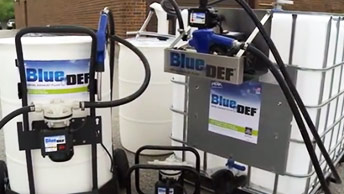
A Guide to Def Storage & Contamination
Originally posted on https://www.peakhd.com/lifeblood/fluid-thinking/a-guide-to-def-storage-contamination/
Diesel Exhaust Fluid is a vital component in today’s emissions compliant engine. It’s a non-hazardous, non-toxic, non-flammable material that lowers NOx concentrations.
DEF does not pose any serious health risks to people, so it is safe to handle. However, in order to get the most out of DEF there are a few procedures your employees need to follow when it comes to storage:
- • DEF should not be stored in direct sunlight. Ideal storage is in a cool, dry ventilated place.
- • The best temperature for storing DEF is 77°F. Higher temperatures will not affect the quality of the DEF, but will impact its shelf life. The quality of DEF also is not affected if the fluid freezes. When stored under optimal conditions — between 12°F and 86°F — DEF has a shelf life of up to two years. If stored in warmer temperatures, shelf life decreases.
- • DEF containers are date coded so you can easily determine the date the DEF was made, which will help you determine if it is still suitable for use in your vehicles.
Contamination
It is imperative that DEF be kept clean from contamination. ISO 22241 provides product purity standards including quality specification for the water used with the urea to form DEF. DEF is comprised of 32.5% urea and 67.5% de-ionized water.
Contaminated DEF can cause problems with the Selective Catalytic Reduction (SCR) system, and can cause premature water pump and injector wear. Contaminated DEF can also leave gummy deposits on the catalyst. Repairing or replacing the SCR unit can be quite costly. You should take every precaution to avoid using contaminated DEF.
To prevent DEF from becoming contaminated make sure the pumps and containers you use with it are not used with other fluids. If you have to clean DEF fueling or storage equipment, do so with de-ionized water to avoid contaminating the DEF.
DEF cannot be stored in containers made of carbon steel, copper or alloys that contain copper or zinc-coated steels.
When choosing a DEF supplier look for one that uses a closed-loop system that provides evidence of tampering. Closed systems use a valve coupling system that seals the opening of the container to prevent contaminants from entering. On the other hand, an open system container lacks this valve, which makes it easier for dirt and other debris to get into the storage container.
If you suspect the DEF has become contaminated, do not use it. You can use a DEF refractometer to test the purity of DEF. A refractometer is designed to measure the concentration of water-soluble fluids. It works by measuring the refractive index, which is the speed at which light passes through a liquid. To check the purity of DEF, apply a few drops to a refractometer that is capable of measuring urea concentrations. They are available in single and dual-scale models. The single scale version shows the percentage of urea by weight, while the dual-scale unit also provides a refractive index scale reading. A single scale version is fine when checking for water dilution.
If the concentration of urea to water is incorrect, do not use the DEF as it can harm your vehicle.
